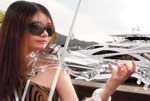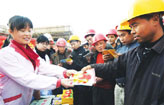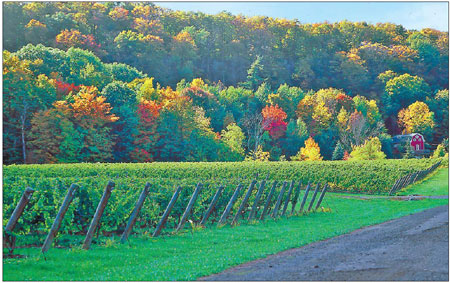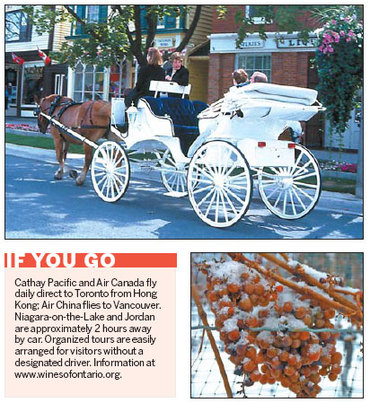Tips and Articles
Legends of the falls
Updated: 2011-04-17 07:52
By Elizabeth Kerr (China Daily)
|
Autumn colors in the vineyards at the Niagara Peninsula light up the landscape, giving a taste of what's to come in winter wine tourism. Provided to China Daily |
|
Top: Hop on a horse-drawn buggy to explore the charms of the hamlets. Bottom: Frozen grapes are kept on the vines for the famous ice wine. |
The "other" side of the mighty Niagara Falls escapes most visitors - the Canadian side with its pretty scenery and world-famous ice wines. Elizabeth Kerr explores.
The New World is making as many waves in Asia's burgeoning wine culture as traditional producers, but California, Australia and South Africa capture the lion's share of the attention - and the shelf space. A taste from odder spots demands a trip to the source. Anyone with a modicum of wine knowledge will agree Ontario ice wines are the best in the world, but its Rieslings and Pinot Noirs elicit giggles.
Ontario wineries experienced their share of growing pains, but lest we forget, Napa Valley was once laughed at, too. Gone are the days of Brights' Baby Duck (if you don't get that reference consider yourself lucky) and sampling the province's wine now unearths a mature industry with some distinct tastes.
With Toronto a major destination for Asian travelers, a trip to Ontario's Niagara region should be seriously considered by any wine buff. The ice wines remain the big draw - the grapes actually freeze after all - but the region was once the province's proverbial fruit basket; a great deal of Ontario's fresh produce came from the fertile land on the north shore of Lake Ontario.
Viticulture was imported to the Niagara region in the 19th century, and the modern wineries kicked things into high gear 30 to 40 years ago.
Ontario has four true wine-growing regions: the smaller, younger north shore of Lake Erie and Prince Edward County, Niagara-on-the-Lake, the Niagara Escarpment and Twenty Valley.
Natural beauty and a vibrant ecosystem make outdoor activities (hiking, biking, fishing and swimming) plentiful if you're not into wine, and Niagara-on-the-Lake hosts the annual Shaw Festival for theater lovers. A summer trip is as lush as you'd expect of any wine country, but a winter trip holds it own charms.
Crowds are smaller, lines are shorter, hotels have more space and most importantly cellar-door staff have plenty of time to show off their wines.
The best way to experience the small hamlets of the area is by car, and it's an easy 90-minute drive west on the Queen Elizabeth Way from Toronto. The QEW is a standard North American highway, but once you hit the town of Beamsville, your wine adventure can begin.
Alternatively, head all the way to the end of the line at Niagara-on-the-Lake (NOTL) and work backwards. But make sure to veer right; the QEW eventually heads left and vaguely south toward the Rainbow Bridge, Niagara Falls and the United States border, which frequently mean traffic snarls.
Niagara-on-the-Lake is a historic town with 19th-century buildings converted into a raft of shops, restaurants, and hotels. For wine lovers the ideal first stop is just outside of town at Inniskillin Wines (www.inniskillin.com), one of the best-known estate wineries in Ontario and perhaps the industry's most important. Founders Donald Ziraldo and Karl Kaiser were the drivers behind the establishment of the Vintners Quality Association (VQA) appellation of origin labelling system (similar to Italy's DOCG and France's AOC), local post-secondary education in viticulture, and they were behind the push for glassmaker Riedel's creation of a dedicated glass for Ontario's signature wine.
Winemaker Bruce Nicholson has a curious, experimental and rather fearless attitude toward wine, and it shows in Inniskillin's diversity. The new East West Series combines grapes from its vineyards in Ontario and British Columbia, and late autumn Rieslings and Cabernet Francs are consistently strong and just a little different than what's expected of each.
A stop at the appropriately monikered The Ice House (www.theicehouse.ca) is a must for ice-wine lovers. Operating out of a converted 1890 peach-processing plant - winemaking gear now sits where horse-drawn carts once hauled in fruit - the winery was founded in 2005 by Karen King and Jaime Macfarlane, both wine industry veterans.
Ice House likes to greet visitors with ice-wine slushies, unlike anything found at 7-Eleven. Most of us wouldn't even consider using a multiple Monde Selection Grand Gold Winner for a slushie, but King is all about transcending ice wine's exclusive image, much in the way the province has to with all its wines.
"We're less attached to the rules and certainly open to trying new things. Ice wine was traditionally seen as a bit of an old-fogey thing, but people are using it now to toast at weddings instead of champagne. It's exciting," she says. Ice House produces a Vidal and Cabernet Sauvignon, and King pairs them with salty and spicy foods as a way of emphasising its versatility. Next up for Macfarlane: Polaris, a spirit made from ice wine.
As you head back toward Toronto, the last stop should be Jordan Village - perhaps a one-horse town, but it's quite a horse.
Located on the Niagara Escarpment and Twenty Valley, the land is a ridge carved by a glacier that also gave birth to Niagara Falls. It's also home to Megalomaniac (best bottle: Narcissist Riesling, with a reverse label for easy mirror reading), Organized Crime, and hockey legend Wayne Gretzky's label.
Jordan is a tiny town dominated by Cave Spring Cellars (www.cavespring.ca) and its sister businesses, Inn On The Twenty and On The Twenty Restaurant. After kicking around in NOTL, a few nights in Jordan is the perfect decompressing tonic.
Spa On The Twenty, like everything else in the Niagara region, will immerse you in all things wine, like its signature Wine Country Wrap, replete with grapeseed scrub and grape mud.
Finally, no trip would be complete without a good meal. A la carte dining is available but On The Twenty's tasting menu, with each course paired with a wine from Cave Spring's cellar - and no ice wine - is the perfect capper.
Cave Spring is called The House that Riesling Built, and it's easy to see why. Its star attraction? A Dolomite Riesling, named for the intensely mineral soil the grapes grow in that give the wine an odd start and a unique, complex finish that makes you reconsider perceptions. As Inniskillin's Nicholson huffs, "People who won't try Canadian wines just don't know," and as the old commercial stated, good things grow in Ontario.
E-paper

Han me downs
Traditional 3,000-year-old clothes are making a comeback.
Reaching out
Fast growth fuels rise in super rich
Chinese tourists spend more
Specials

Big spenders
More mainland tourists are expected to spend money on overseas travel this year.

Rise in super rich
Report cites rising property prices, gdp as key drivers of increasing number of chinese millionaires.

Reaching out
Condom makers are stepping up their presence in smaller cities to boost sales


